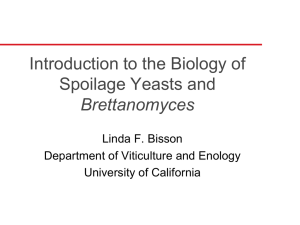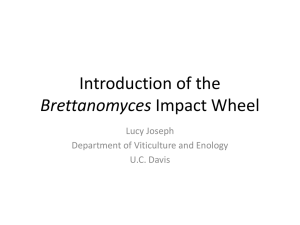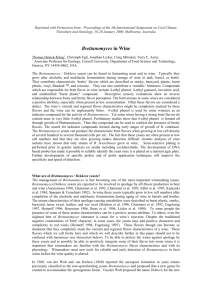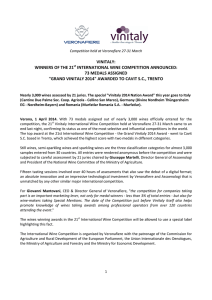Access the file
advertisement
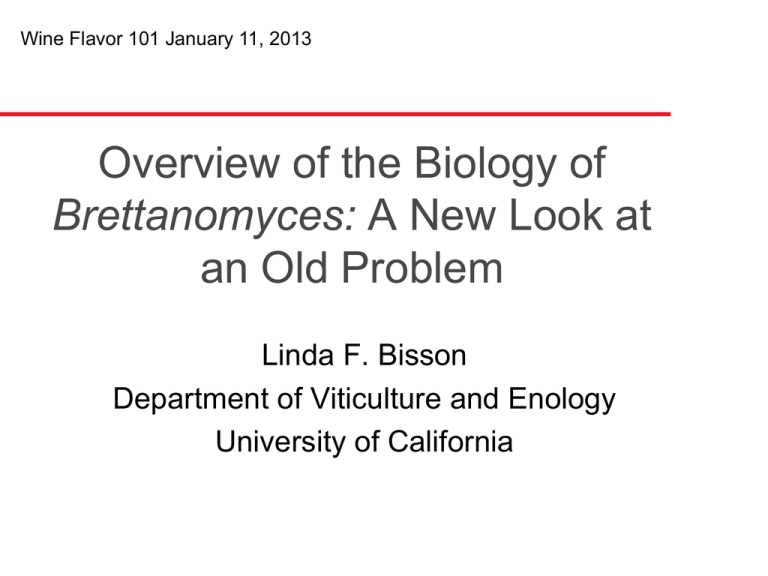
Wine Flavor 101 January 11, 2013 Overview of the Biology of Brettanomyces: A New Look at an Old Problem Linda F. Bisson Department of Viticulture and Enology University of California Brettanomyces The Old Problem . . . Historical Background Brettanomyces is a budding yeast found widely distributed in nature Discovered in beer in 1904 (Claussen), in wine (Krumbholz & Tauschanoff,1930) and again in 1940 (Custers) Results in a variety of aromas – English Character or Lambic Beers – Spoilage/Regional Character in Wines Historical Background Brettanomyces produces a wide array of aromatic compounds Brettanomyces cellar contamination was widespread Brettanomyces characters became synonymous with “terroir” and regional signature Brettanomyces characters can compete with varietal characters for dominance of wine profile Taxonomy Anamorphic/non-sexual form: Brettanomyces Teleomorphic/sexual form: Dekkera Several species are found: B. bruxellensis, B. anomala, B. custerianus Characteristic traits: – – – – – Ascomycete yeast Reproduce by budding Observation of sporulation is rare Pseudohyphae formed Fermentation end products: acetic acid and CO2 dominate – Fermentation more rapid in presence of air: Custer’s effect Morphology Cell Morphology – Ogival, bullet shaped, non-uniform – Sometimes arranged in pseudohyphae. Ascospore Morphology – Conquistador hatshaped – 1 to 4 spores/ascus Brettanomyces Genomics Chromosomal number varies by strain Chromosome configuration not well preserved Not a simple haploid or diploid – Hybrid between two strains with similar but different genomes? – Diploid progenitor that lost the ability to engage in sexual reproduction (genome renewal) Accumulation of allelic differences and polymorphisms – Hyper-mutagenic? – Defective in repair? Metabolism of Brettanomyces Can use numerous sugars, ethanol, other carbon compounds, and even amino acids as carbon sources Can survive in very nutrient poor condition Can survive and metabolize in extreme environments and is found in VNC states Produces diverse metabolic end products from grape components: » Volatile Phenols » Tetrahydropyrazines Brettanomyces Characteristics Highly metabolically versatile Capable of ethanol production from sugars anaerobically Produce acetic acid from sugars aerobically Can produce viable petite (non-fermenting) off-spring Brettanomyces and Oxygen Oxygen stimulates growth, acetic acid formation and glycolysis Oxidation of acetaldehyde to acetic acid is favored over reduction to alcohol Leads to depletion of NAD+ Requires co-substrates or oxygen for acetic acid production Redox state of cytoplasm has a strong impact on metabolites produced Brettanomyces vs. Saccharomyces Saccharomyces: grows 5 times faster Brettanomyces has slightly higher ethanol yields (1015%) Saccharomyces produces more glycerol (6 fold higher) Brettanomyces produces more biomass (20 to 30% more) Brettanomyces more tolerant of large changes in pH and temperature Brettanomyces has a more energy-efficient metabolism: can do more with less Brettanomyces vs. Saccharomyces Saccharomyces – Whole genome duplication – Domestication events – Reversible adaptation Brettanomyces – Intensified local adaptive evolution – Terminal, non-reversible adaptation Brettanomyces vs. Saccharomyces Whole genome duplication (Saccharomyces: buy all the gear I need and carry it with me) vs. Intensified local adaptive evolution (Brettanomyces: live off the land) Both strategies allow successful adaptation to challenging environments and enable switching between metabolic modes. The WGD is more confining of subsequent strain integrity; strains are more similar than in the case of intensified local adaptive evolution What Does This Mean for Winemakers and Consumers? Significant diversity in compounds produced by Brettanomyces strains Regional specificity of compounds produced due to highly adapted local populations Spoilage Organism or Agent of Regional Character? Brettanomyces makes a host of aromatic compounds Compounds made differ by strain Compounds made differ by winery Compounds made differ by vineyard Brettanomyces Role as a Spoilage Organism Brettanomyces Spoilage Characters Vinyl phenols Ethyl phenols Isovaleric Acid Biogenic amines – Putrescine – Cadaverine – Spermidine Acetic acid Host of other compounds Production of Vinyl Phenols by Brettanomyces OH OH H H Cinnamate CH OH decarboxylase CH CH H Vinyl phenol reductase CH2 CH2 CH2 COOH H = coumaric OH = caffeic OMe = ferulic The Main Spoilage Characters Three main phenolic spoilage compounds: – 4-Ethylphenol (band aid) – 4-Ethylguaiacol (smoky medicinal) – 4-Ethylcatechol (horsy) Isovaleric acid (rancid, sour, vomit and sometimes barnyard note) Is That Character Desirable? Detection threshold varies with varietal from 126 to 420 ppb of 4-EP depending upon matrix Recovery Thresholds: – 50% of tasters can detect 605 ppb in wine or 440 ppb in water of 4-EP Chatonnet has defined spoilage as: – >426 ppb of 4-EP and 4-EG – >620 ppb of 4-EP Incidence of Spoilage Country >426ppb >620ppb France 36% 28% Italy 49% 19% Australia 59% 46% Portugal 42% 27% Wines may contain up to 50 ppm (!) of 4-EP Vinyl Phenol Formation Detoxification? Co-Substrate? Vinyl Phenol Formation 4-EP formation is growth associated 4-EP formation not correlated with acetic acid formation High 4-EP producers tolerate higher environmental levels of p-coumaric acid When Is It Spoilage? High concentration, dominating wine profile Conflict with wine matrix characters Suppression of varietal character Enhancement of off-notes Lactic acid bacteria often found in wines with Brettanomyces The Wirz Strain Trial Take a large collection of 35 Brettanomyces strains: 17 Strains from CA, 1 from NY, 1 from MO, 4 from France, 2 from Germany, 2 from New Zealand, 2 from Chile, 2 from Malta, 2 from Belgium, 1 from Canada, 1 from Thailand Perform descriptive analysis with trained panelists following growth in Cabernet Sauvignon wine 14 panelists participated The Main Aromas Found: Band-Aid (4-Ethyl Phenol) Earthy (Geosmin) Horsy Leather Putrid Soy Tobacco The Standards 8 aroma standards were selected by the panelists: – Soy (Soy Sauce) – Band-Aid (4-Ethyl Phenol) – Horsy (Horse Sweat-soaked Towel) – Putrid (Burnt Fava Beans) – Tobacco (Shredded Cigarette) – Leather (Leather Shoelace) – Earthy (Geosmin) ANOVA Analysis of Variance (ANOVA) showed that the variance in the data for 5 of the 7 attributes could be explained by the wines: – Band-Aid, horsey, earthy, putrid, soy. (p<0.06) – Leather and tobacco judge interaction was too high 3 PC2 (27.9%) Black: CA Pink: Canada Lavender: NY Blue: MO Red: France Green: Germany Orange: Chile Dark Blue: NZ Brown: Belgium Light Green: Thailand -3 2091 2076 2092 1 Bandaid 2054 2093 2059 2052 2065 2060 2079 2080 738 -2 2 2049 2067 2041 752 -1 2050 2063 0 1 Control 2066 Earthy 2062 2051 2053 2085 Soy 2058 Horsey 2081 2083 0 2030 2046 2077 2078 2 3 Putrid 2082 -1 615 2075 2047 -2 2048 -3 PC1 (41.4%) What Does This Mean? There is a group of strains that showed no effect on the wine: grew but no off-characters were produced Other strains showed differing impacts on the wine Aroma groupings were observed: – Band-Aid & Soy vs. Earthy & Putrid; Horsey vs. nothing. All vs. nothing. Correlation of descriptors – Earthy and Putrid are very highly correlated, Band-Aid and Soy, Soy and Horsey also correlated but less highly Lessons Learned Strain diversity evident in same wine: strains use different metabolic strategies Not much correlation with geographical location of origin Many strains were on the “positive” side: not just absence of off-characters Some panelists seemed to be “blind” to some characters as the consensus descriptor Subsequent Studies Lucy Joseph: GC-Olfactory Brad Kitson: Role of specific precursors in wine Beth Albino: Survey of strains, precursors and diversity of aromatic impressions: Birth of the Brett Aroma Wheel Lucy Joseph: Metabolomic analyses, refinement of Brett Aroma Wheel Brettanomyces The New Look Brettanomyces Aroma Impact The sensory analysis demonstrated that different strains impact the same wine in different ways Some of the Brettanomyces-infected wines were “preferred” over the control in judge comments Judges disagreed on the nature of the positive descriptors New goal: better understanding of the positive impacts of Brettanomyces on wines Brettanomyces and Regional Character Local Brettanomyces strains contribute to the expected aromatic profile of wines when allowed to bloom during aging Some people, cultures, population segments are attracted to those characters Many more people are attracted to the positive Brettanomyces characters if the vinyl phenols and isovaleric acid contributions are minimized Brettanomyces Characters Are described differently by different people Strongly trigger complex memory responses See the perception phenomenon of “filling in the aroma gap” Show strong matrix effects Can add to complexity The Brett Aroma Impact Wheel Not a typical descriptive analysis Wanted the consensus terms but also breadth of descriptors The Search for a Neutral/ Positive Strain Neutral Strains: may be useful in making wines stable against further Brettanomyces infection via consumption of residual nutrients Positive Strains: may impart some of the spicy, complex characters Brettanomyces is known for minus the negatives Better understanding of metabolism may lead to a better understanding of the negative impacts of wine and allow better prediction of which wines to use for this “style” The Search for a Neutral/ Positive Strain Variations in vinyl phenol production Not consistently stable Strong matrix influence that is not well understood Bottom Line: Brettanomyces cannot be trusted metabolically, but if historical winery experience is positive and there is no subsequent adaptive pressure, the positive influence may recur Today’s Program: AM The Brettanomyces Signature Spoilage Characters – Spiked Cabernet Wine Influence of Matrix: – Characters in different wines » Smoky Red Fruit Grenache » Gamy Pinot noir » Barbera Today’s Program: PM Brettanomyces Aroma Impact Wheel – Tasting of Merlot Wine with Different Strains – Tasting of Brett “suppressed and salvaged” wine Brettanomyces in Commercial Wines: – Winemaker Panel – Tasting of Commercially wines with Brett contributions: selected by use of Aroma Impact Wheel descriptors
